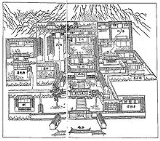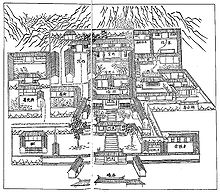
Yamen
Encyclopedia
- Not to be confused with YemenYemenThe Republic of Yemen , commonly known as Yemen , is a country located in the Middle East, occupying the southwestern to southern end of the Arabian Peninsula. It is bordered by Saudi Arabia to the north, the Red Sea to the west, and Oman to the east....
, the nation in the Middle East.

Bureaucrat
A bureaucrat is a member of a bureaucracy and can comprise the administration of any organization of any size, though the term usually connotes someone within an institution of a government or corporation...
's, or mandarin
Mandarin (bureaucrat)
A mandarin was a bureaucrat in imperial China, and also in the monarchist days of Vietnam where the system of Imperial examinations and scholar-bureaucrats was adopted under Chinese influence.-History and use of the term:...
's, office and residence of the Chinese Empire. The term has been widely used in China for centuries, but appeared in English
English language
English is a West Germanic language that arose in the Anglo-Saxon kingdoms of England and spread into what was to become south-east Scotland under the influence of the Anglian medieval kingdom of Northumbria...
during the Qing Dynasty
Qing Dynasty
The Qing Dynasty was the last dynasty of China, ruling from 1644 to 1912 with a brief, abortive restoration in 1917. It was preceded by the Ming Dynasty and followed by the Republic of China....
.
Within the yamen, the bureaucrat administered the government business of the town or region. Typical responsibilities of the bureaucrat includes local finance, capital works, judging of civil and criminal cases, and issuing decrees and policies.
Typically, the bureaucrat and his immediate family would live in a residence attached to the yamen. This was especially so during the Qing dynasty
Qing Dynasty
The Qing Dynasty was the last dynasty of China, ruling from 1644 to 1912 with a brief, abortive restoration in 1917. It was preceded by the Ming Dynasty and followed by the Republic of China....
, when imperial law forbade a person from taking government office in his native province.
Yamen varied greatly in size depending on the level of government they administered, and the seniority of the bureaucrat's office. However, yamen at a local level typically had similar features: a front gate, a courtyard and a hall (typically serving as a court of law); offices, prison cells and store rooms; and residences for the bureaucrat, his family and his staff.
At the provincial level and above, specialisation among officials occurred to a greater extent. For example, the three chief officials of a province controlled the legislative and executive, the judicial, and the military affairs of the province or region. Their yamen would accordingly be specialised according to the functions of the office.
After 1911
The institution of the yamen fell victim to the Wuchang UprisingWuchang Uprising
The Wuchang Uprising began with the dissatisfaction of the handling of a railway crisis. The crisis then escalated to an uprising where the revolutionaries went up against Qing government officials. The uprising was then assisted by the New Army in a coup against their own authorities in the city...
and the Xinhai Revolution
Xinhai Revolution
The Xinhai Revolution or Hsinhai Revolution, also known as Revolution of 1911 or the Chinese Revolution, was a revolution that overthrew China's last imperial dynasty, the Qing , and established the Republic of China...
, after which warlords
Warlord era
The Chinese Warlord Era was the period in the history of the Republic of China, from 1916 to 1928, when the country was divided among military cliques, a division that continued until the fall of the Nationalist government in the mainland China regions of Sichuan, Shanxi, Qinghai, Ningxia,...
often wound up becoming the ultimate authorities, in spite of Sun Yat-sen
Sun Yat-sen
Sun Yat-sen was a Chinese doctor, revolutionary and political leader. As the foremost pioneer of Nationalist China, Sun is frequently referred to as the "Father of the Nation" , a view agreed upon by both the People's Republic of China and the Republic of China...
's best efforts to establish a Republic of China
Republic of China
The Republic of China , commonly known as Taiwan , is a unitary sovereign state located in East Asia. Originally based in mainland China, the Republic of China currently governs the island of Taiwan , which forms over 99% of its current territory, as well as Penghu, Kinmen, Matsu and other minor...
covering all of China. Sun Yat-sen tried to establish a form of self-government, or home rule
Home rule
Home rule is the power of a constituent part of a state to exercise such of the state's powers of governance within its own administrative area that have been devolved to it by the central government....
, on a regional (or local) basis, but he found that he needed bureaucracy
Bureaucracy
A bureaucracy is an organization of non-elected officials of a governmental or organization who implement the rules, laws, and functions of their institution, and are occasionally characterized by officialism and red tape.-Weberian bureaucracy:...
to run a country as big as China. Hence, new bureaucratic offices arose, thus replicating the functions of the Imperial yamens in many ways.
The term yamen is still used in colloquial Chinese today, however, to denote government offices. It sometimes carries negative connotations of an arrogant or inefficient bureaucracy
Bureaucracy
A bureaucracy is an organization of non-elected officials of a governmental or organization who implement the rules, laws, and functions of their institution, and are occasionally characterized by officialism and red tape.-Weberian bureaucracy:...
, much as the term "mandarin
Mandarin (bureaucrat)
A mandarin was a bureaucrat in imperial China, and also in the monarchist days of Vietnam where the system of Imperial examinations and scholar-bureaucrats was adopted under Chinese influence.-History and use of the term:...
" does in English.
Notable yamens
- The Zongli YamenZongli YamenZongli Yamen was the government body in charge of foreign affairs in imperial China during the late Qing dynasty. It was established by Prince Gong in 1861, following the Convention of Peking. It was abolished in 1901 and replaced with a Foreign Office of ministry rank.The former site of the...
acted as an office of foreign affairs in the late Qing dynastyQing DynastyThe Qing Dynasty was the last dynasty of China, ruling from 1644 to 1912 with a brief, abortive restoration in 1917. It was preceded by the Ming Dynasty and followed by the Republic of China....
. - The yamen at Kowloon Walled CityKowloon Walled CityKowloon Walled City was a densely populated, largely ungoverned settlement in Kowloon, Hong Kong. Originally a Chinese military fort, the Walled City became an enclave after the New Territories were leased to Britain in 1898....
, Hong KongHong KongHong Kong is one of two Special Administrative Regions of the People's Republic of China , the other being Macau. A city-state situated on China's south coast and enclosed by the Pearl River Delta and South China Sea, it is renowned for its expansive skyline and deep natural harbour...
is an important historical site. - The Presidential Palace (Nanjing)Presidential Palace (Nanjing)The Presidential Palace in Nanjing, China, housed the Office of the President of the Republic of China before the republic relocated to Taiwan in 1949. It is now a museum, the China Modern History Museum. It is located at 292 Changjiang Road, in the Xuanwu District of Nanjing.-History:In the Ming...
was modified from the "yamen" of the Governor-General of the Two Jiangs.

